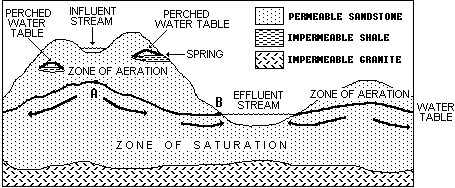1. A rock could have porosity but not permeability if the pores were very small and / or not interconnected with one another.
2. The downward flow of water though the open spaces in a rock or sediment is eventually stopped by some type of impermeable rock at depth (an aquitard).
3. 
4. Losing (=influent) streams tend to occur in dry climates, whereas gaining (=effluent) streams are found commonly in wet climates.
5. An artesian aquifer is pressurized, so water in an artesian well will rise in the well above the aquifer.
In order for artesian wells to exist, the aquifer must be sandwiched between two aquitards, and the aquifer must be tilted and exposed at the surface somewhere to allow for recharge.
6. If groundwater is over used (draw>recharge), some or all of the following events might occur:
(1) The groundwater resource may be used up.
(2) Land subsidence may occur. This happens because as the water table lowers, the buoyant force that groundwater exerts on earth materials will be lessened. The result is that the land may settle over the area where the groundwater has been removed. Subsidence can be extreme if caverns are present, and sinkholes may develop.
(3) In coastal areas, pumping out fresh groundwater can result in a raising of the saltwater / freshwater interface. If too much fresh water is pumped, saltwater will eventually enter the well.
(4) When too much water is used from a well a cone of depression forms, lowering the water table next to the well relative to surrounding areas. This will tend to cause water in the zone of saturation to flow from distant areas towards the well thus increasing the probability that the well may become polluted.
7. a. If the area is underlain by coarse gravel or cavernous limestone, groundwater flow would be rapid, hence the cone of depression which would form at A would be poorly developed and little pollution would flow toward A. Rapid flow means little purification, so well B would be badly polluted.
b. If the area is underlain by sand with a little silt and clay, groundwater flow would be slow, hence a well developed cone of depression would form at A and it would receive a lot of pollution. On the other hand, B would get relatively pure water as the slow flow would allow enough time for purification to take place.
9. A geyser erupts periodically whereas a hot spring does not because the relatively simple plumbing in a hot spring prevents the water from getting superheated by allowing convection to move heat to the surface. Superheating does occur in a geyser because it’s complex and constructed plumbing system hinders convection. Superheating causes the water to expand greatly and results in outflow. By removing water from the geyser, outflow lowers the pressure on the superheated water which results in boiling. Boiling causes more outflow. A chain reaction begins which accelerates and culminates in an eruption.
10. Speleothems do not form in the zone of saturation. They form in the zone of aeration as CO2 comes out of solution from groundwater entering caverns from above. The removal of CO2 causes the groundwater to become less acidic causing dissolved minerals precipitate.
11. Karst topography is characterized by the presence of landforms related to groundwater erosion - such as caverns and sinkholes. Such landforms are formed in humid climates underlain by soluble rocks such as limestone, marble, or rock salt.

8800 Grossmont College Drive
El Cajon, California 92020
619-644-7000
Accessibility
Social Media Accounts